The story of 6 Moray Place concerns two Glasgow family firms; first the slippery business of the Fergusons, specialists in soap, oil and lubricants, and second the bunnetry of the Grays, hat and cap manufacturers. The following is research based on the database entry for 6 Moray Place. The Ferguson family is well documented on Ancestry.co.uk by the user GKang, with pictures from user Ian Faris, and the following includes a summary of that work .
John Alexander Ferguson
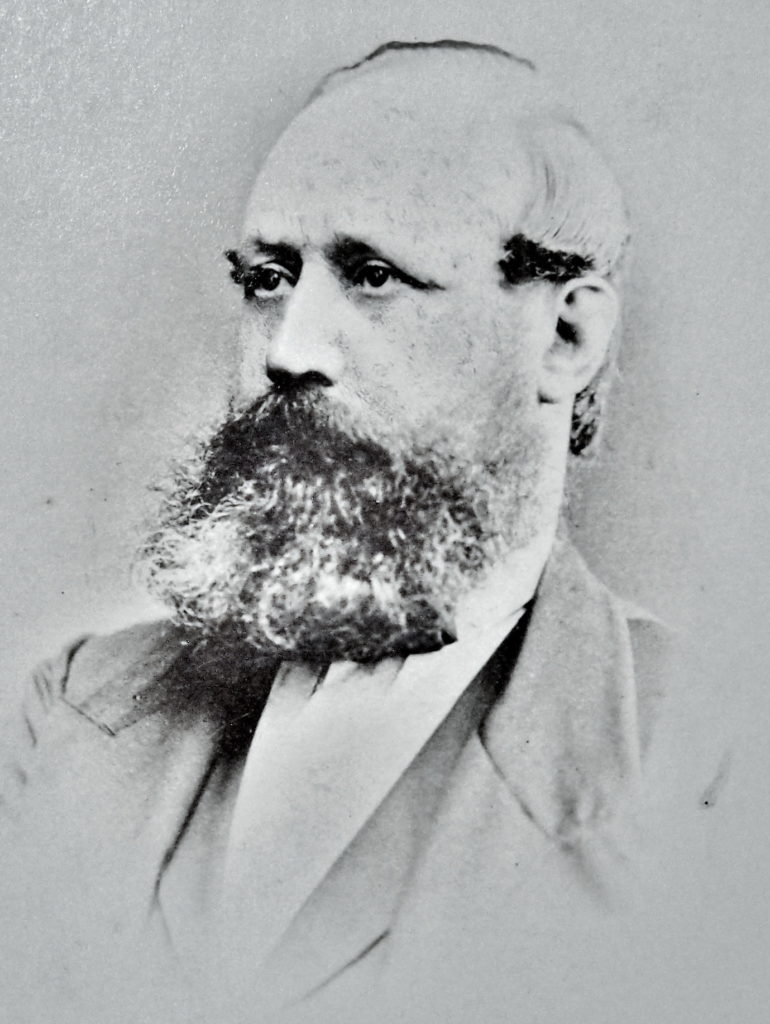
John Alexander Ferguson. Source: Ian Faris, Ancestry.co.uk
John Alexander Ferguson was born to William Ferguson, a smith and farrier, and Mary White, both of Muirkirk, on 27 February 1819 at Garscube Road in Port Dundas. Mary died in 1825 and William remarried. Of thirteen children, 10 of whom were boys, John was the oldest surviving son.
John married Elizabeth Ferguson, daughter of David Ferguson and Mary Ann Galt of Girvan, in Nicholson Street in September 1846, and they had nine children over the next seventeen years. They lived in the Gorbals and Tradeston in the 1850s. Addresses included Crown Street, and in 1861 at 8 South Apsley Street, but business was good and shortly after they moved to the newly built property in Moray Place, where their final child Alice was born.
Some letters survive; Elizabeth added a note to a letter of her husband’s in 1848, which gives some idea of how difficult life could be in the Gorbals, even for the better off.
My dear Aunt,
John is writing to Uncle and as there is some spare room I can do no better than fill it up, altho I have nothing of importance to communicate to you. There is a sort of gloom over the city at present on account of the rapid increase of Cholera it is truly distressing to see so much Mortality. May God in his great Mercy arrest the Contagion and prepare us all for whatever is before us. I expected to have seen you in the summer and cannot invite you to spend the New Year with us till matters look better I trust the keen frost that has set in may purify the atmosphere. We were glad to hear from Uncle’s letter that your English friends were all well. I write this in the office and they are waiting for having it posted. My sweetheart smiles with me with kind love to Uncle and Yourself,
From your affect. niece Elisa.
She was lucky however, as all her children survived to adulthood.
In 1874 Elizabeth died at 6 Moray Place aged 51, after years of ill health. Her daughter Alice described her as “a little old lady, brought to the table at mealtime, then taken to her room.”
John died suddenly at 6 Moray Place in 1878, aged 59. He was buried at Sighthill. The Ardrossan and Saltcoats Herald recorded his passing thus:
Our Masonic readers will regret to learn the demise of Br J A Ferguson, which took place at his residence, 6 Moray Place, Glasgow, on Sabbath last. To not few of his friends, far and near, the news of his death was as startling as a lightning flash from out a clear sky. Mr Ferguson had long enjoyed the best of health; in fact it was his boast that he never knew what it was even to have a headache. It appears, however, that he had not felt so well on Thurdsay week, and after acareful examination by the family doctor, it was found that he was suffering from an affection of the heart. He was advised to take perfect rest for a few days and refrain from anything of an exciting nature. On Sabbath morning, he appeared to regain his wonted health and spirits, but it was apparently a sudden burst of sunshine through the dark cloud – the last flicker of the flame of life. He expired at two o’clock, his spirit quietly passing away without a moment’s warning.
Mr Ferguson was initiated into the craft in the Master Lodge, Kilwinning, in January 1867 and as an evidence of the respect entertained for him by the brethren he was within a few years afterwards, appointed Senior Warden representative in the Grand Lodge of Scotland, a post he continued to fill with the utmost satisfaction to the brethren.
Mr Ferguson possessed a genial spirit, and his frank and kindly influence warmed every circle in which he moved; and now that he is gone from amongst us, his name will be held in remembrance not only by the members of the Mother Lodge, but by the Craft in many parts of Scotland.
He was one of the successful Glasgow merchants, having been in business for 40 years. Much of his success was due to his sterling worth and uprightness of character.
John & Elizabeth’s Children
Mary (1848-1921)
Mary Ferguson, the eldest child, was at Moray Place in 1871, but married an Australian, Edward Gould, and emigrated to Sydney. In 1876 they returned to Glasgow before settling in London.
Elizabeth (1850-1900)
Elizabeth married James Law Paterson, a warehouseman and drapery salesman, in 1874.
Jane (1851-1937)
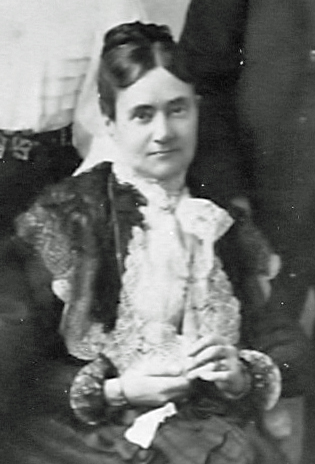
Jane Ferguson. Credit: Ian Faris
Jane married Hector McLean in 1876 at Moray Place. He was an agent of Seville Sulphur & Copper in Liverpool, and so they moved to Lancashire. She regularly visited Moray Place and was described as “very prim and proper, rather eccentric and with little sense of humour, disapproving of them smoking and wearing lipstick.” She was devoutly religious, and her bequests in her will on her death in 1937 indicated a distinct dislike of the Roman Catholic fraternity. A donation to a Liverpool hospital included the codicil “my Trustees shall so far as possible ensure that no Roman Catholic shall ever derive any benefit from the money so contributed.”
John Alexander Ferguson, Junior (1853-1923)
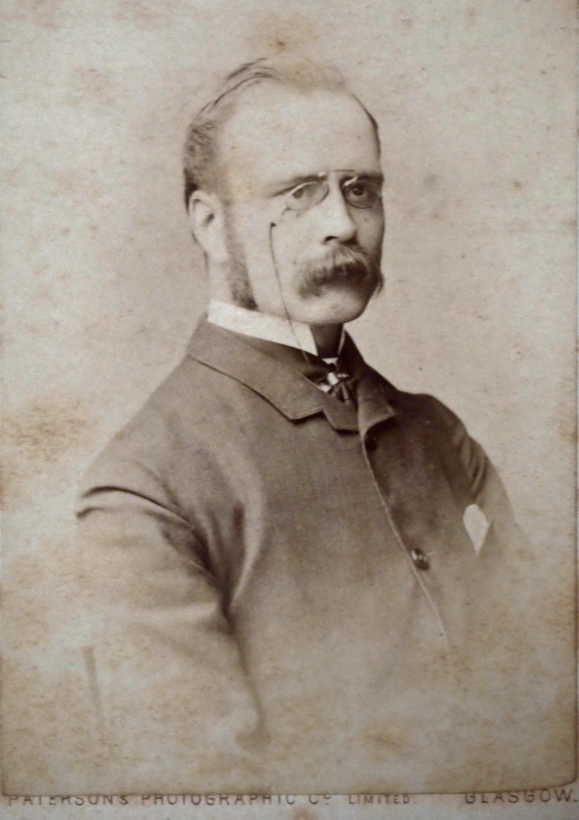
John Alexander Ferguson Junior. Source: Ian Faris, Ancestry.co.uk
John junior was the fourth child, but first son, of John and Elizabeth. Born on 17 January 1853 in the Gorbals, he trained as an analytical chemist, and followed his father into the family business, taking over on his death.
He was admitted as a Hammerman of Glasgow in 1882, following in his father’s and grandfather’s footsteps.
John remained at Moray Place until 1895, with his brothers David and George and sisters Annie and Alice. He moved to 14 Derby Crescent (now Botanic Crescent) in North Kelvinside, then in 1900 he purchased Kilmeny, 10 Kirklee Road, where he eventually retired, and died on 16 February 1923. He never married, but lived with his sister Alice.
Annie (1854-1942)
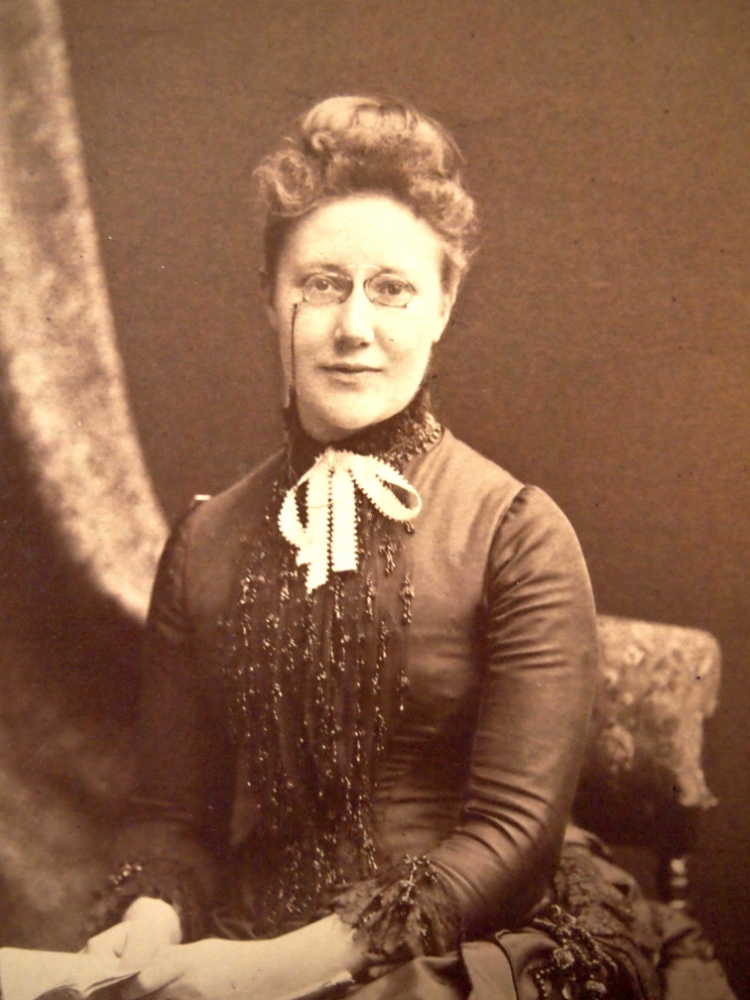
Annie Ferguson. Credit: Ian Faris
Annie ran the household at Moray Place after her parents died. She remained single despite many suitors, until she married a widowed doctor, David Sloane, in 1905 at 51, at her brother’s house, Kilmeny. They settled in Catrine, where he practised for many years.
William (1856-1916)
William left Moray Place in 1875 at 18 to travel to Australia as his family thought it would be “good for his character”. He married his cousin Elizabeth Ferguson, daughter of William Ferguson of Hobart, and went into law with his father-in-law’s practice. The family came back in 1896 and moved to Cambuslang, but eventually returned to Australia and settled in Melbourne, exporting Tasmanian apples to the UK.
David (1859-1936)
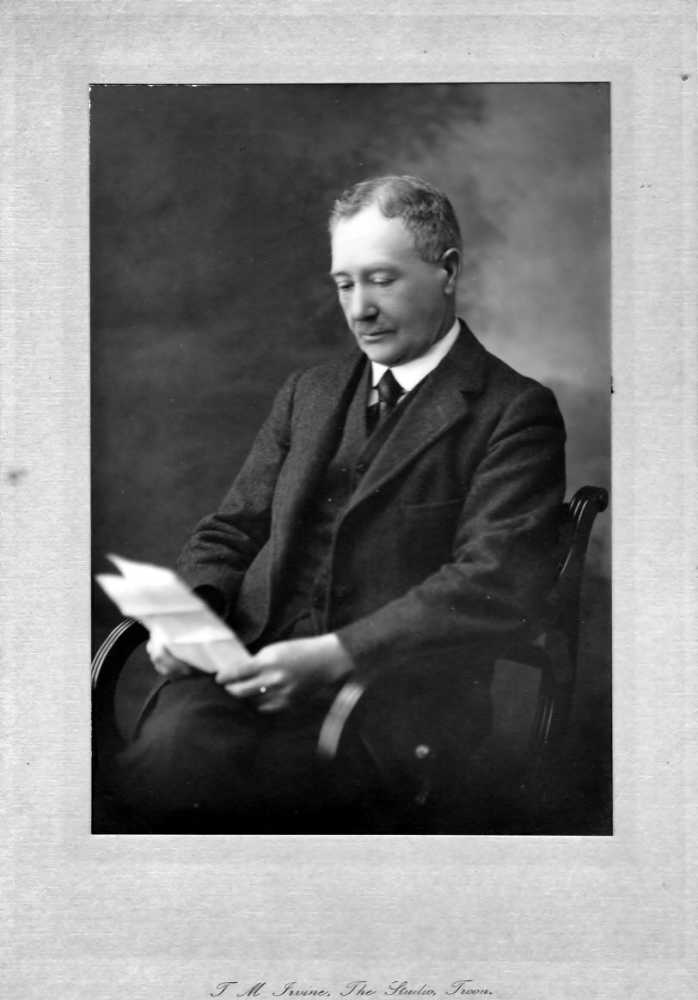
David Ferguson. Credit: Ian Faris
David emigrated to Melbourne, Australia where he was a wine & spirit merchant for Taylor, Ferguson & Co, which also had Glasgow and Manchester branches. He married Norah Varian, an Irish nurse, in Melbourne.
George (1860-1956)
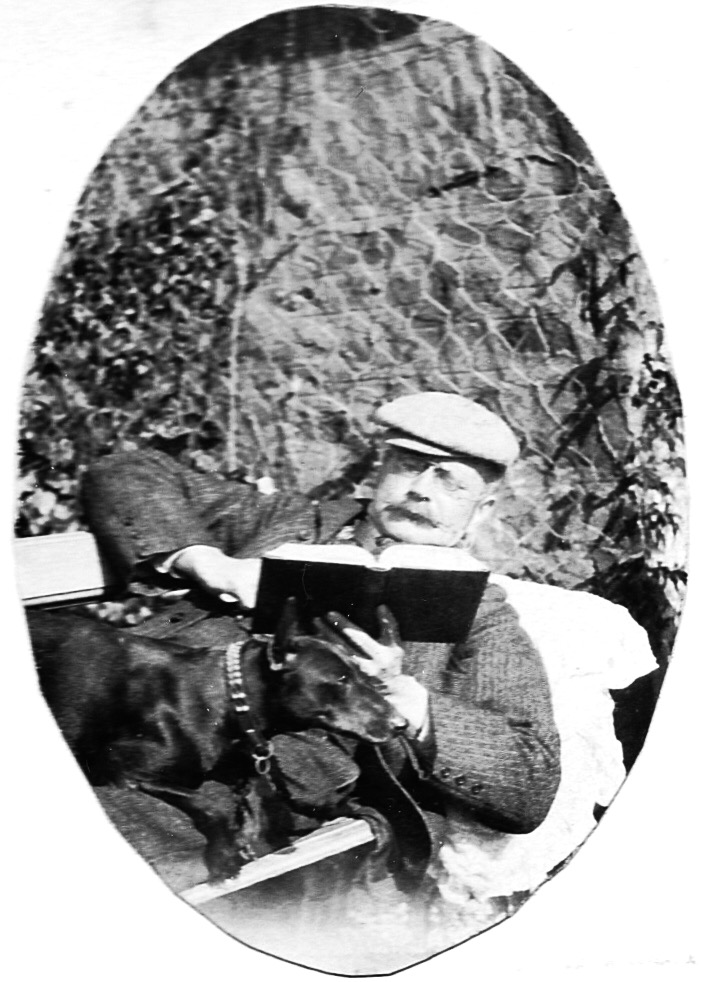
Uncle George Ferguson with Prince the dog. Credit: Ian Faris
George studied law, but continued to live at Moray Place into the 1890s with his brother John, and sisters Annie and Alice. He married his housekeeper, Margaret Muir Turner, in 1895 at the Grand Hotel, and rented 5 Princes Square (now 12 Marywood Square) with his wife and two servants, Jane Nicholson and Ryeburn J McMillan from 1895-1901. By 1905 they too had moved to North Kelvinside. Margaret died in 1917 and he didn’t marry again. He succeeded his brother John as a senior partner in Ferguson, Shaw & Sons. He retired in 1953 at the impressive age of 92 and died in Troon.
Alice (1863-1953)
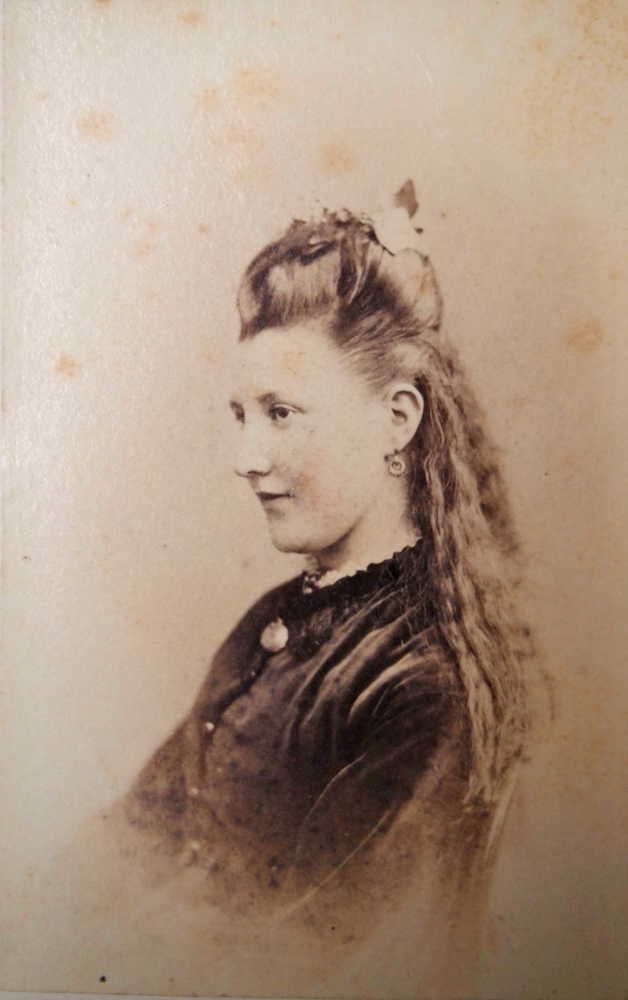
Alice Ferguson. Credit: Ian Faris
Alice was born at Moray Place on 25 January 1893. She became a music teacher, and then spent 5 years at the Leipzig Conservatorium. She lived with her brother John and moved with him, and Mary Marshall the cook, to Kilmeny. She kept a cockatoo, but it had to be sent to Edinburgh Zoo when its seeds were rationed in the war, and she used to travel to pay it visits. She stayed at Kilmeny until her own death in 1953, when it was sold.
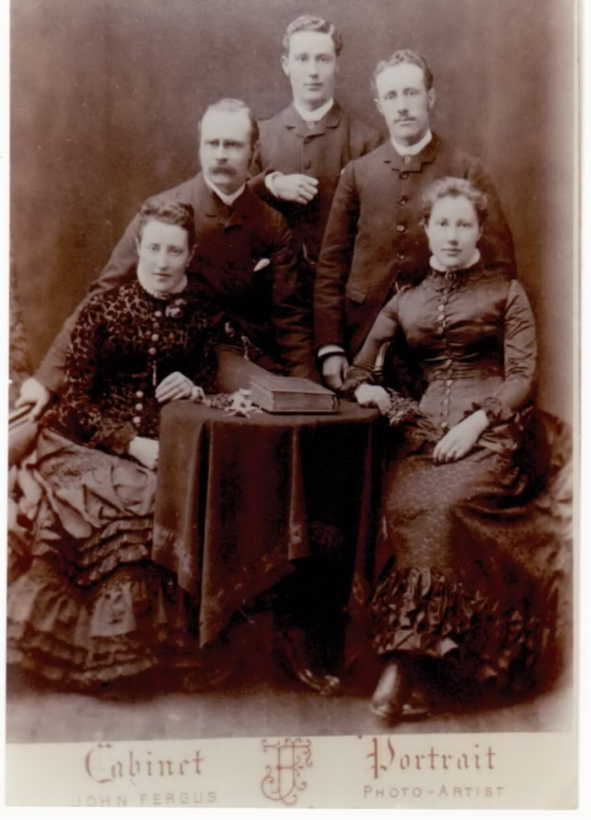
John, George, David, Alice & Annie Ferguson, who all lived at Moray Place in 1881. Source: Ian Faris, Ancestry.co.uk
William Hay Ferguson
Cousin William Hay Ferguson was the son of John Ferguson Senior’s brother William, who after a period in the navy, had jumped overboard and fled, settling in business in Hobart, Tasmania. William Junior did not settle down to study, so his father handed him to a ship’s captain, an old friend, saying “here is a boy who needs teaching to do as he is told. Use the rope end if necessary.” William, who was to be given only a penny whenever they reached port, was only 13. His ship was rammed in a fog by a larger ship as it neared England and sank with the loss of a number of the crew. William, who had enough of the sea, was pleased when his father cabled giving him permission to stay in Scotland to attend school.
He arrived in Glasgow in the spring of 1881, staying with his cousins at 6 Moray Place just in time to appear in the 1881 census, and he attended Anderson’s College, forerunner of the University of Strathclyde. His family joined him in Glasgow in May 1882, planning to resettle in Scotland, but after just 18 months he decided to return to Australia, and his family went back with him, sick of the Scottish weather. He had an adventurous life, dabbling in a gold rush or two, a Fijian sugar, plantation and farming, before settling on Flinders Island. His first wife died in another shipwreck.
The Servants
I don’t normally write about the servants, as their presence is fleeting and they are not easy to trace, as is the case for Catherine McNeil, Mary Marshall and Annie Davidson – I can’t find a Catherine McNeil born on Skye, and there are too many Mary Marshalls in Glasgow. John did however leave Mary Catherine Marshall £300 in his will for her long service, and Mary died at Sorn on 31 July 1941 after “50 years devoted friend in the family”.
Marion Sneddon, however, has left a trail.
Born in Cambusnethan around 1853, in 1871 she was an 18 year old servant at Moray Place looking after John’s family, including eight children aged 8 to 23. She must have been busy.
In 1872 she married coalminer James Hamilton and they had 7 children. Her husband died in 1899 and she made an application for Poor Law Relief in 1904, when she was still looking after four teenage daughters. She was noted to be suffering from phthisis (tuberculosis) at the time, and she died that year .
Ferguson, Shaw & Sons
By 1843 John was established as a candle-maker in partnership with William Fullarton Shaw as Ferguson & Shaw, candle makers. Their Stockwell Street business expanded and they described themselves in 1863 as “tallow melter and candle manufacturers, dealers and commission agents in oil, lard, provisions and agents for Ferguson & McEwan, New York”. They were joined by Alexander Buchanan Dick in 1866 but this partnership was dissolved circa 1871.
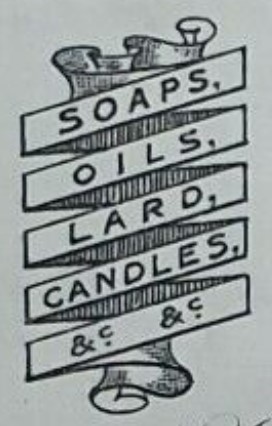
Ferguson, Shaw & Sons logo, from an invoice. Source: eBay
In 1870 they took over Ferguson & McLaren’s operations, including their works at Old Wynd, close to their Stockwell St premises. Their number of employees increased from seven in 1861 to 57 in 1871.
The business saw changes, with the building of the tracks to the new St Enoch Station disrupting their Stockwell Street premises, so they expanded by buying out the Gleniffer Soap Works of Paisley, and later Ivie Hair & Co.
When John Alexander Ferguson died in 1878, his son, also John Alexander, took over from him.
By 1904 they had moved to Bishop Street in Port Dundas. The firm made the front page of the Glasgow Herald in 1914 when their oil works in Port Dundas caught fire.
The Port Dundas district of Glasgow was visited last night by a conflagration which consumed two large works occupied by oil merchants and tallow chandlers, and spreading across a narrow thoroughfare, involved the Parish Church of the district, and endangered a tenement of dwelling houses locally known as “the Irish land.” When the fire brigade assembled on the scene of the outbreak it was at once realised that the oil warehouses involved were past saving. It became their business to prevent as far as possible the spread of flames to adjoining property. A south-west wind was blowing freely at the time, and was so “tricky” as to give the firemen the greatest apprehension.
The warehouses involved are situated in Dobbie’s Loan and belong to a firm which traded under the name of Messrs Ferguson, Shaw & Son and Ivie Hair & Co. When the alarm was given shortly after six o’clock Superintendent Gillon, the fire brigade chief commanding in Mr Waddell’s absence in London, at once realised the seriousness of the situation. Every division was ordered out and the four sides of the faces of conflagration were surrounded by eager and hard working men. The affair required disciplined handling. What the scene was like no one except within the cordon observed by the firemen and police can describe. Two huge works containing most inflammable stuff, candles to whale oil, were doomed. The fire continued to rage in the interior and as it reached each tank of oil, a loud explosion occurred, and the flames burst forth with renewed vigour and were borne on the breeze towards the houses on the opposite side of Dobbie’s Loan. So intense was the heat the large crowds who had gathered in the vicinity had to retire.
John Jnr died in 1923, and his younger brother George became the family’s senior partner until his retirement in 1953. The company described itself as “Contractors to the Admiralty and War Office, Manufacturers of All Kinds of Hard and Soft Soaps, Tallow Melters and Refiners, Aucarine Motor Oils and Greases, Manufacturers of all Varieties of Machinery, Marine Engines and Cylinder Oil, Importers and Refiners of Seal Cod, Whale and Fish Oils.”
The firm continued to trade from the Imperial Oil Works on Renton & Tyndrum Streets in Port Dundas until 1994 when the business was sold to an English firm by the last member of the Shaw family to hold an interest .
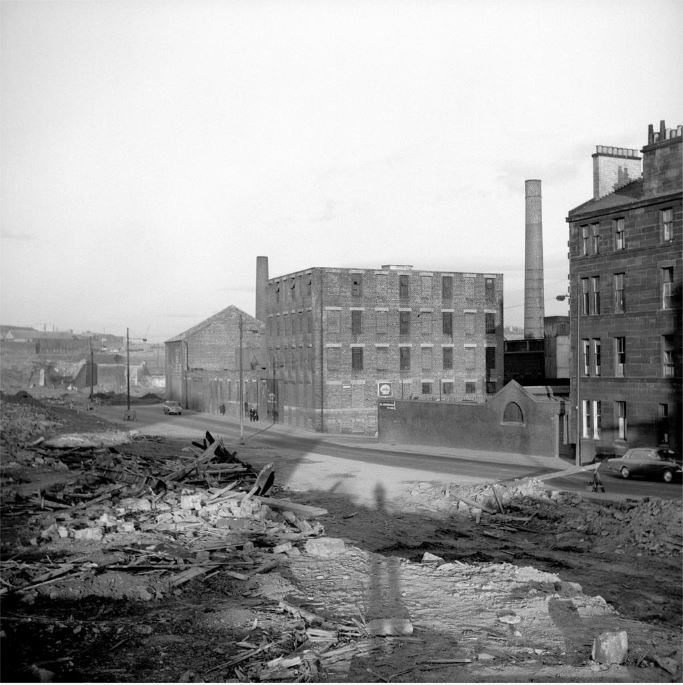
Imperial Oil Works, Port Dundas, 1967. Credit: HES/Prof John R Hume
The grease that launched a thousand ships?
One of the more unusual products was Tallene, a grease especially formulated for the launching of ships. It helped ease the Queen Mary down the slipway , and probably the QE2 also. There is little information on Tallene, though such grease was usually manufactured from tallow and whale oil.

Launch of the Queen Mary on a bed of Tallene, 1934, from the launch commemorative brochure. Source: WorldNavalShips.com
James Gray, hat & cap manufacturer
Brothers James, William and John Gray were living at 63 George Street in 1861, boarding with Andrew Inglis, of Andrew Inglis & Co, hat and cap manufacturers at Moodies Court, 31 Argyle St & 43 Argyle Street. James was 23 and a hat & cap manufacturer, William a hat & cap manager, and John a hat & cap clerk.
In 1866 James was still working for Inglis. He appeared to go into partnership with another cap manufacturer, John Knox, but the partnership was dissolved and James & John took over the debts.
By 1868 James & John Gray were at 43 Argyle Street and Inglis had vanished, while William was already an independent hatter further down Argyle St. James lived at 12 Kelvingrove Street and John at 1 Cumberland Street.
By 1870 William had disappeared from the PO Directories and probably died young in 1871.
James purchased 6 Moray Place from the Fergusons in 1895, and lived there until his death in 1922 . He was made a justice of the peace in 1902.
James’ son William Gray was born in 1863. He married Jessie McCulloch Anderson, the daughter of James Black Anderson, another hat manufacturer on Argyle Street. They lived at 22 Leven Street, Pollokshields and had a daughter Maggie in 1892, but Jessie died in 1900 aged only 36.
William then lived at Moray Place until at least 1930. He was also a hat & cap manufacturer, and appears to have taken over the company of James & John Gray.
Thomas Steele Campbell
In the Post Office Directory of 1939-1942 the resident was one Thomas Steele Campbell. He ran a ladies outfitters business in Great Western Road which went bust in 1912. He was an employee of Fairfield Shipbuilding in 1930 when living on Pollokshaws Road. Thomas married William’s daughter Maggie Gray in 1927 at the St Enoch Hotel, and they presumably inherited the house on William’s death.
Additions and corrections welcome.

June 20, 2023 at 11:41 pm
Do you have any information for William and Isabel Russell owning 6 Moray Place during 1964 and some years after. They were my great aunt and uncle and I recall visiting them during the summer months. I believe it was 6 Moray Place, a lovely house with many fun hiding places:) My Uncle as I was told was in the ‘woolen’ industry…… that is all I know. I would love to find plans for the home to know about the dimensions and design, as a child you seem to remember things “bigger’ than perhaps they were. Thank you.
July 3, 2023 at 12:39 pm
Further info provided by Charlene:
I’m Charlene Dixon Kolacki and the great niece of the late William and Isabel Russell. I was born in Glasgow in the mid 50s with my Nana and most of my Scottish family living in Ayr. My great aunt and uncle William and Isabel Russell used to own a home in Moray Place. I used to think it was 5 Moray Place but in looking at Google it must have been 6 Moray Place due to the placement of the door and windows. When I was younger and living in England, my Aunt and Uncle would have me stay with them for about two weeks in the summer and then take me to my Nana’s house in Ayr. I’ve often wondered about the home. I have so many memories of the home. This is a strange request but if anyone could find me a floor plan of the home. I try to describe the beautiful rooms, the large windows, the long staircase…..of course I was 7 – 10 when I spent time with them in the summer so maybe the home is really not as large as I remember:) What I can remember is entering the home, on the right was a large sitting room, with another room adjacent that had a long hallway down to the kitchen and a door to the back steps, where my Aunt did her laundry in a stone building out in the back. At the end of the hallway was another small sitting room almost under the stairs that looked out back and my Uncle used that room as a library/office. I believe counting the stairs when I was little and I remember 32 stairs (I was amusing myself) but surely that cannot be right:) At the top of the stairs walking straight ahead was another large sitting room that they had two suites of furniture and a piano, with closets at the far end – I would actually hide from my aunt and scare her:) Turning right at the top of the stairs was a smaller bedroom that was my room when I stayed there. Turning left at the top of the stairs would lead to the bathroom where she had lovely black and white tiles on the floor, leaving the bathroom turning right led to the primary bedroom. I remember it being large and it had a sink in it….I always thought that strange but I liked it. I know this is a strange request but would love to have any more photos that might be available or at least the dimensions of the rooms. Without of course, invading in anyone’s privacy. My Mom was Evelyn Beaddie, she used to sing with the Andy Curray Band at the Bobby Jones in Ayr. She also had her own Studio of Dance for many years. My Uncle James Beaddie worked for the Scottish Ambulance company and my Grandfather James Beaddie was a caretaker and porter and man of many skills at the old Heathfield Hospital on Heathfield Road in Ayr. My cousin is now a paramedic at the same Depot my Uncle worked at. I share all of my ‘history’ of family in the hope of finding further details of the home I spent many fun summer hours in. The years I spent with were the summers of 64, 65 and 66. Thank you so very much for anything you might be able to share with me, or with the current owner to see if they are willing to share any interior photos of the rooms. My sincere regards and thanks. Charlene Dixon Kolacki, Everett, Washington USA